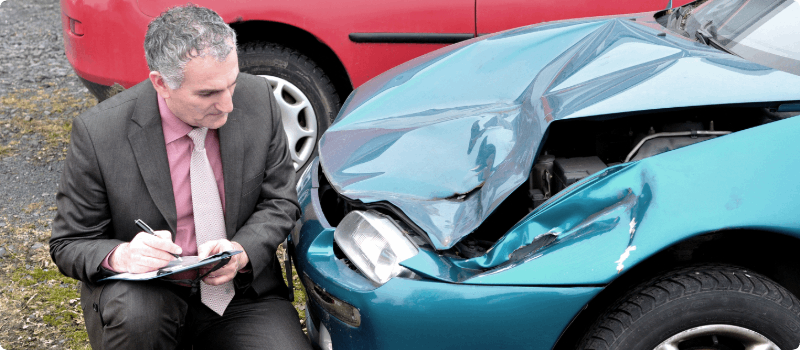What is auto gap insurance, and what does it cover?
Updated March 28, 2024 . AmFam Team
Heading to the dealership to pick up your new set of wheels makes for one awesome day! Whether you decide to finance, lease or purchase your new car outright, the decision is entirely up to you. Either way, you’ve worked hard to secure the finances needed to make that car purchase a reality. To protect your investment, and because you’re a responsible driver, you probably have collision coverage to help protect your car if you get into an accident and your vehicle is totaled.
However, collision coverage may only help pay out the actual cash value of your vehicle — in other words, the “fair market value” — which is often less than what you still owe on your car.
When the amount you’re paying for your car is more than the car’s fair value, it creates a gap in your coverage — and you're financially responsible for that gap.
But fear not; this is where gap insurance comes into play. It may help you avoid additional out-of-pocket expenses. Lease and loan gap insurance may help cover the difference in the event of a total loss.
Let’s take a closer look to see if you need gap insurance and how gap insurance may help financially protect you.

Do I need gap insurance?
First and foremost, do you lease or finance your car? Leasing or financing your vehicle can indicate that you may need gap coverage, but only sometimes.
If you made a small downpayment when you purchased your vehicle, having gap coverage is important because you likely have a sizable outstanding loan.
The value of your car can depreciate quickly. If you get into an accident on the way home from the dealership, you could be upside down (when you owe more than the car's worth) within minutes of your new purchase. Gap insurance may help protect you by covering what you still owe after your insurance pays the actual cash value of your vehicle if it’s totaled.
This coverage can only help protect you if you owe more than your car's value. If you owe less than what your car is worth, gap insurance can't help. If you decide to forgo gap coverage, ensure your loan balance consistently stays below your vehicle's actual cash value.
Assuming the value of your car is less than what you owe on your loan, gap insurance may help protect you from a substantial loss.
What does gap insurance not cover?
Having gap insurance coverage may help financially protect you if you total your car and still have your lease or loan to pay, but don’t confuse its purpose — here’s what gap insurance does not cover:
- If you’re having trouble making your car payments due to a financial hardship, disability, loss of job, etc.
- Any repairs to your vehicle
- The carry-over balance on a loan you may have rolled over into your new car loan
- Paying for a rental car while your vehicle is in the shop
- Extended warranties added to your car loan
- A down payment for a new car
- Reduced value of your car after an accident
Simply put, lease and loan gap insurance coverage may help cover the difference between the amount you owe on your car and its actual cash value if it's totaled in a covered accident. It protects you from paying for a vehicle you can no longer drive while also having to pay for another car.

How does gap insurance work?
According to Edmunds.com (Opens in a new tab), when you drive your vehicle off the dealership lot, its value depreciates around 11%. That means your car is already worth less than what you paid minutes ago.
Here’s an example of how gap coverage works:
You buy a car for $30,500, make a $500 down payment and take out a $30,000 loan with monthly payments of $400.
Now, imagine four months later, you get into an accident, and your car is totaled. Your insurance company decides the actual cash value of your vehicle, or its fair market value, is $26,000. They may pay this much (minus your $500 deductible) through your insurance policy's collision coverage.
However, due to the structure of your loan payment, you still have $29,500 to pay on the loan, leaving a gap of $3,500. Without gap insurance, you’d be responsible for paying that entire difference. However, you may only be responsible for the $500 deductible with gap insurance.
Having gap insurance helps eliminate this deficit because your insurance company may also help pay that gap of $3,000.
Do I need gap insurance on a lease?
Gap insurance may help protect you if you lease your car, which operates similarly to financed vehicles. That given, you may owe more on your lease contract than it's worth because its value depreciates when you drive it off the dealership lot.
If you total the car, you’re responsible for the gap between its fair market value and lease balance. Your insurance company may help pay the actual cash value of your leased car, but you are responsible for that gap.
Some things to keep in mind about gap insurance for your leased car:
Gap insurance is vital for those leasing a car. That’s why many leased vehicles include gap insurance by default. Before you purchase gap insurance, ask your leasing company, dealership and leasing insurance company if it's included.
If you lease or finance your car, your dealership will typically require comprehensive and collision coverages. You can add the gap coverage with those coverages.
Your deductible is usually not covered by gap insurance, but some plans may pay your deductible, so be sure to check with your provider. It's also worth noting that you may have to continue paying your lease payments until your insurance claim is settled.

Does gap insurance cover theft?
Many auto insurers offer gap insurance for theft, but it's important to confirm your coverage details with your agent. If your gap insurance covers stolen vehicles, your insurance company must declare your car a total loss for you to benefit from the coverage.
That can happen in two ways: if your vehicle is recovered with enough damage from the people who stole it, or if it's never recovered. Usually, insurers have a waiting period, which allows time for your car to show up.
Gap insurance is key if your car is stolen. If your insurance company declares it a total loss, they may help pay its fair market value, but sometimes, that's less than what you still owe. If you don't have gap insurance, you're responsible for the full gap balance.
Is gap insurance required?
Typically, gap insurance is only essential if you lease or finance your car and its value is less than what you owe. Many times, if gap coverage is required, it will be included in the vehicle's contract for a fee. Confirm your coverage requirements with your dealership and insurer.
Even if gap insurance isn't required, adding it usually only adds a few more dollars to your monthly or biannual policy, but it may be able to save you a lot of money in the long run.
How to get gap insurance
You can often purchase gap insurance at the dealership, but it may be less expensive if you buy it from an insurance company. Check with your agent to see how much it would cost to add the coverage to your policy.
Remember, if you lease your vehicle, the coverage may already be included in your lease contract, so ask your dealer if you’re protected and how much you’re paying for the coverage.
Now that you know why you may need gap coverage, connect with an American Family Insurance agent and visit our lease/loan gap insurance page. Your agent can help you add this smart coverage to protect you from the unexpected.
This information represents only a brief description of coverages, is not part of your policy, and is not a promise or guarantee of coverage. If there is any conflict between this information and your policy, the provisions of the policy will prevail. Insurance policy terms and conditions may apply. Exclusions may apply to policies, endorsements, or riders. Coverage may vary by state and may be subject to change. Some products are not available in every state. Please read your policy and contact your agent for assistance.
This article is for informational purposes only and based on information that is widely available. This information does not, and is not intended to, constitute legal or financial advice. You should contact a professional for advice specific to your situation. You'll need to also keep the bundle disclaimer.
*Customers who bundle home and auto insurance policies may save up to 23% on both policies together (as of December 2023). Discounts may vary by state, property, policy form and company underwriting the home and/or auto policy. Discounts may not apply to all coverages on a home or auto policy.

